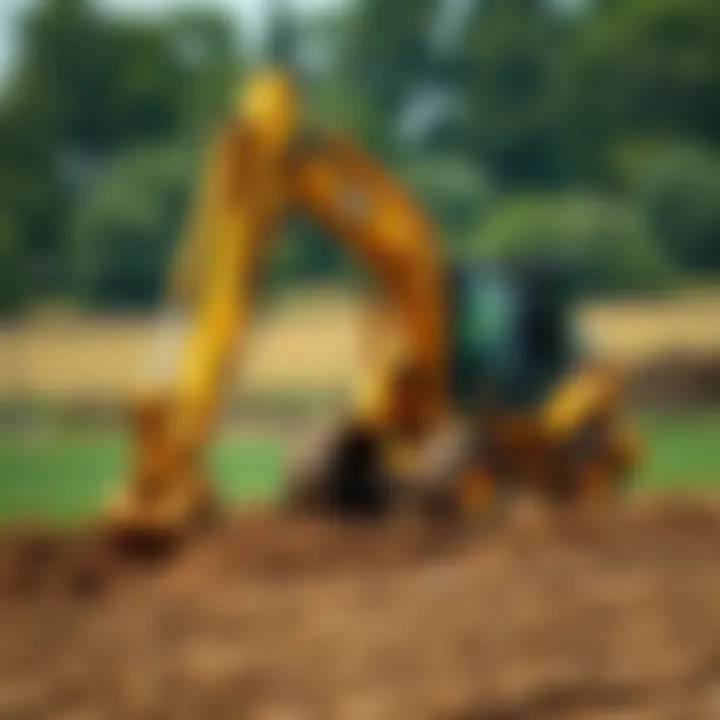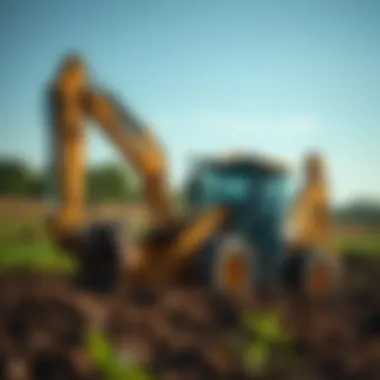Digger Excavation Techniques in Modern Agriculture


Key Insights
Overview of the Topic
Digger excavation is one of those unsung heroes in modern agriculture, yet it plays a pivotal role in enhancing farmland productivity. To understand how diggers reshape agricultural practices, we need to look at the machinery involved, the methods employed, and the practical implications for sustainability. By diving deep into both time-tested and cutting-edge techniques, we can appreciate their significance in today’s farming landscape.
Importance in Agriculture
In the world of agriculture—where every square inch counts—efficient land preparation allows for better crop yield and improved soil health. Diggers, also known as excavators or earth movers, come armed with various attachments designed for a specific task, such as trenching, grading, or even lifting heavy loads. Farming today is not just about sowing seeds; it’s about creating an environment conducive to robust growth. The effective use of diggers can lead to a smarter approach to irrigation, drainage, and soil aeration, vital factors in achieving sustainable agriculture.
Sustainable Practices
Eco-Friendly Techniques
Modern methods of excavation have taken strides toward sustainability. With increased awareness about ecological concerns, farmers and contractors are now turning toward practices that minimize disruption to the land. For instance, using GPS technology allows for precision excavation that reduces excessive land disturbance, which in turn protects the existing soil structure and natural ecosystems. Also, adopting machinery that runs on alternative energy sources can greatly lessen the carbon footprint.
Examples of Eco-Friendly Techniques
- Vertical Tillage: Reduces soil compaction.
- Conservation Tillage: Helps retain moisture and nutrients.
- Hydraulic Excavation: Minimizes soil erosion through controlled movements.
Case Studies on Sustainability
Several farms around the globe serve as golden examples of successful sustainable digging practices. A commendable case is the California Sustainable Winegrowing Alliance, showcasing how proper excavation techniques can maintain soil health while enhancing vineyard productivity. An interesting aspect here is their commitment to using less water in irrigation, achieved partly through smart digger techniques that create effective drainage systems. Documentation of these practices can be found on various platforms including National Agriculture Library and Sustainable Agriculture Research and Education.
Tools & Resources
Essential Equipment and Technologies
The landscape of excavation in agriculture is continuously evolving. Equipment such as trenchers, backhoes, and bobcats may ring a bell, but advancements in technology are pushing the envelope further. Drones are becoming indispensable for surveying fields, while telematics systems help in tracking machinery performance remotely.
Recommended Books and Readings
- Soil Health and Sustainable Agriculture by Ellen Davis
- Excavation and Grading Handbook by William C. Bock
- Articles from American Society of Agricultural and Biological Engineers
The intersection of digger excavation and modern agricultural practices offers fertile ground for both innovation and sustainability. As we better understand these mechanisms, we make strides toward a more responsible approach to farming that not only feeds the present but also nurtures the future.
Foreword to Digger Excavation
Digger excavation plays a crucial role in the evolution of agricultural practices, acting as the backbone of effective land preparation and soil management. Understanding the nuances of excavation is essential not just for modern farmers but also for agronomists, landscapers, and even enthusiasts who cherish the connection between land and productivity.
In this section, we’ll discuss the significance of digging in agriculture, the essential machinery involved, and the historical context that shapes current practices. Grasping these elements provides valuable insights into effective farming strategies, ensuring more efficient use of resources and better crop yields.
The Role of Digging in Agriculture
Digging serves multiple purposes in agriculture, impacting everything from land preparation to drainage management. To put things simply, without the right digging techniques, a farm might as well be a ship lost at sea. Efficient excavation enables farmers to create field beds, trenches for irrigation systems, and channels for proper water drainage. All of this contributes to well-aerated soil, which is vital for crop growth.
Additionally, the process of digging is closely tied to soil preparation. For instance, the act of turning the soil allows the incorporation of organic matter, enhancing its nutrient availability. Moreover, specific digging methods can improve soil structure, which affects water retention and root development.
To sum up, the role of digging is multi-faceted when considering agricultural success. It acts as a tool for cultivation, promoting sustainable practices that can lead to high-yield harvests and reduced environmental impact.
Historical Context of Excavation Techniques
Stepping back in time, one can see how excavation techniques have evolved from rudimentary hand tools to advanced machinery. In ancient agricultural societies, farmers relied on pickaxes and shovels, precisely crafting the land using sheer physical effort. The introduction of animal-drawn plows marked a significant leap, giving farmers the means to cover more ground and perform deeper digs.
With the Industrial Revolution came the mechanization of agriculture. Tractors and early excavators started to redefine the landscape of farming. For instance, the introduction of the tractor in the early 20th century vastly increased the speed at which land could be prepared. Diggers became more specialized, focusing on tasks such as trenching and grading.
Today, modern diggers, such as mini diggers and excavators, incorporate advanced hydraulic systems that offer precision and power, tailoring the art of excavation to meet specific agricultural requirements. Understanding this historical trajectory helps one appreciate how current excavation techniques have been honed over centuries to support efficient and sustainable farming practices.
"From hand tools to high-tech diggers, the journey of excavation reflects the ingenuity and persistence of agricultural advancement."
In essence, as we delve deeper into this article, we will dissect the machinery, techniques, and best practices that are shaping the future of agricultural excavation.
Types of Diggers and Their Functions
Digger excavation techniques stand at the forefront of modern agricultural practices. Understanding the various types of diggers is crucial for optimizing efficiency and effectiveness in the field. Different kinds of diggers serve specific purposes, making them invaluable for various tasks from trenching to land preparation. These machines not only alleviate sheer manual labor but also enhance productivity, driving advancements in sustainable agricultural practices.
Mini Diggers
Specifications and Uses


Mini diggers, often referred to as compact excavators, are small yet mighty machines utilized predominantly in tight or confined spaces. Their specifications vary broadly, ranging from a compact width of around 0.8 to 1.5 meters and a digging depth usually between 1.5 to 3.5 meters. The lightweight construction makes them perfect for residential projects, landscaping, and even agricultural endeavors like digging irrigation trenches.
What's more, the unique swivel boom found on many mini diggers aids in maneuverability, allowing operators to dig right up against fences or walls—something larger machines simply can't do. These machines are favored for being user-friendly and cost-effective, making them an excellent choice for small farms or urban gardening setups.
Advantages in Small Spaces
The ability of mini diggers to excel in small or urban settings is an invaluable attribute. Their compact size enables farmers to work in tight corners or limited spaces where traditional equipment may fail to operate efficiently.
Here are a few reasons why mini diggers shine in such environments:
- Precision Work: They allow for more precise digging, which is essential for detailed landscaping or small plots of vegetable gardens.
- Less Ground Disturbance: Their lighter weight reduces the impact on the earth, preventing unnecessary soil compaction.
- Lower Fuel Consumption: They typically consume less fuel than larger counterparts, making them more economical to operate.
However, the limitation lies in their power; for larger excavation tasks, a mini digger may struggle to perform optimally. Still, for niche operations, they remain unsurpassed.
Excavators
Hydraulic Systems and Performance
Excavators are the heavyweights in the world of digging machinery, equipped with robust hydraulic systems. This hydraulic power enables incredible force for digging, lifting, and moving large amounts of earth. Their design usually consists of a boom, arm, and bucket, making them versatile for various tasks in agricultural settings and construction sites alike.
The hydraulic system's efficiency translates into improved performance, allowing operators to switch attachment tools swiftly. Whether it’s a bucket, auger, or grapple, an excavator can adapt in the blink of an eye, bolstering its utility in construction of irrigation systems or foundations for buildings.
Adaptability for Various Tasks
The adaptability of excavators serves as a compelling reason for their popularity among farmers and builders. From digging ditches to clearing land, the multifunctionality ensures they can be utilized for various projects.
Some specific attributes that underline their value:
- Interchangeable Attachments: Their ability to fit various attachments enhances their operational scope. A farmer might use an excavator’s grapple for moving heavy boulders one day and switch to a spreader for planting the next.
- Heavy-Lifting Capabilities: Large quantities of soil or materials can be moved seamlessly, which significantly reduces project times.
Nevertheless, their size can be a disadvantage in smaller agricultural plots where space is premium. Despite that, their performance and efficiency often justify the trade-off for broader applications.
Backhoe Loaders
Versatility in Agricultural Settings
Backhoe loaders embody a unique combination of a digger's digging capability and loader's lifting potential. In agriculture, they are revered for their versatility—using one machine to achieve various tasks, from digging to carting materials.
Key characteristics include:
- Double Functionality: Farmers can use them for both excavation and loading, offering a 2-in-1 solution.
- Ease of Maneuverability: Their articulating design allows for better turning radius, ideal for navigating tight farm spaces.
This adaptability lends itself well to seasonal tasks like planting and harvesting, making them a significant asset in agricultural operations. Yet, the limitation lies in the relatively lower digging depth compared to dedicated excavators; if one requires extensive depth, the backhoe may fall short.
Limitations of Backhoe Loaders
While backhoe loaders offer numerous benefits, they come with their own sets of disadvantages. Primarily, their range of motion is less than that of a full-sized excavator, limiting their digging capabilities for deeper soil.
Some considerations to note:
- Shallower Excavation Depth: They may not reach depths often needed for subsurface drainage or other intensive tasks.
- Weight Distribution: Muck and heavier materials can lead to instability if not handled with care, presenting challenges for less experienced operators.
In summary, knowledge of different types of diggers and their functions not only helps in making informed choices but also drives operational success in agriculture. By leveraging the distinctive advantages of each type, farmers can streamline operations, enhancing productivity while maintaining sustainable practices.
Operational Techniques in Excavation
In the realm of agriculture, operational techniques in excavation play a crucial role in determining not just the efficiency of land preparation but also the health of the soil post-excavation. These techniques influence everything from crop yield to sustainable farming practices. For farmers and agricultural enthusiasts, understanding these operational methods can lead to improved productivity and more conscientious stewardship of land.
Preparation Before Digging
Site Selection and Assessment
Before a single scoop of soil is turned over, the importance of site selection and assessment cannot be overstated. This involves evaluating the topography, existing vegetation, and accessibility of the site. A well-thought-out selection process minimizes adverse effects on plants and wildlife.
One key characteristic of site selection is its focus on the potential impact on soil health and crop success. An ideal site is not solely determined by current conditions; it also anticipates future agricultural needs.
On the up side, a well-chosen site allows for optimized digging and machinery usage, reducing time and eliminating unnecessary costs. However, a common drawback may involve unforeseen regulatory approvals or land-use conflicts, which can delay the process significantly.
Understanding Soil Types


Understanding soil types is another essential aspect of the preparation phase. Different soil types dictate the techniques you'll use, the machinery required, and the overall strategy for excavation. Sandy soils may allow for quicker drainage, while clay-rich areas could prove troublesome due to compaction issues.
The diverse characteristics of soil, such as texture and moisture retention, are fundamental for deciding on digging techniques. Recognizing these features helps to reduce risk of soil erosion and increases efficiencies in excavation tasks. Yet, soil differences can pose challenges during excavation. Notably, they can lead to the miscalculation of time and equipment required for effective digging.
Execution of Digging Tasks
Best Practices For Efficiency
When actual digging begins, applying best practices ensures that the task at hand is executed without hitch. This area encompasses strategies like proper equipment selection, operational methods, and timing to improve efficiencies. Taking advantage of weather conditions and choosing the appropriate time of year helps in enhancing productivity.
One significant characteristic of these practices is the focus on workflow optimization. When farmers align their digging tasks with natural elements—the likes of prevailing weather conditions—they can hammer down the required effort and maximize output. Despite the advantages, one must be careful to plan for disruptions like unexpected rain or machinery breakdowns which can halt progress.
Safety Protocols in Excavation
Safety protocols are non-negotiable during excavation. The machinery involved can pose dangers, and implementing comprehensive guidelines is paramount not only for worker safety but to mitigate environmental impacts. Best practices may include having proper training for operators and ensuring that safety gear is always used.
The unique feature of these protocols is their ability to safeguard both people and the land. It's widely recognized that when protocols are adhered to, not only are injuries minimized, but there is less chance for soil structure degradation during excavation. However, the downside can be the time required to train personnel effectively, which might slow down operations temporarily.
Post-Digging Practices
Inspection and Maintenance
Once the digging is done, inspection and maintenance steps cannot be overlooked. This phase addresses the machine's condition, ensuring preventive measures are taken to enhance durability and performance. Regular inspections can catch potential issues before they escalate, saving costs in the long run.
The core characteristic here is about creating a sustainable operational model. Taking time for machinery upkeep translates to fewer breakdowns, allowing for uninterrupted workflow in the long term. On the flip side, a downside can arise from delays in inspections, which may necessitate scheduling adjustments in future tasks.
Restoration of Disturbed Land
Lastly, restoration of disturbed land after digging is a vital practice that emphasizes ecological responsibility. This stage involves strategies such as reseeding and soil amendment to encourage re-establishment of local plant life. Not only does this promote soil health but also ensures alignment with sustainable agricultural practices.
The defining feature of land restoration is its direct impact on promoting biodiversity. By nurturing disturbed land back to its original ecosystem, farmers not only invest in their land’s future but aid local wildlife. However, challenges may emerge if rapid restoration is neglected, leading to erosion or loss of soil nutrients, counteracting previous benefits of excavation.
In summary, operational techniques in excavation reveal a nuanced approach to how digging aids in sustainable farming efforts. Each phase, from preparation to post-digging, contributes to maximizing productivity while taking significant consideration for the land's health and future viability.
Impact of Excavation Techniques on Soil Health
The relationship between excavation techniques and soil health is a pivotal one in modern agriculture. As farmers and agricultural professionals seek to maximize their yields, an understanding of how various digging methodologies affect the land can safeguard the future of farming practices. Proper excavation techniques not only promote efficiency in land preparation but also play a critical role in maintaining the intricate balance of soil ecosystems.
Digging can lead to benefits such as improved drainage and aeration, while improper methods may result in significant ecological disturbances. This could lead to a strong depletion of nutrients vital for crop growth. Therefore, taking a closer look at the impact of these techniques is essential for farmers looking to harmonize productivity with environmental responsibility.
Effects on Soil Structure
Soil structure refers to the arrangement of soil particles and the spaces between them, which is vital for plant growth. When diggers are used correctly, they can enhance soil structure. This can mean loosening compacted layers, allowing for better root penetration and water infiltration. For instance, when soil is dug carefully around root zones, it promotes a healthier interaction with water and nutrients, fostering a more resilient crop.
Conversely, aggressive excavation can disrupt this natural structure. Over-digging or the use of heavy machinery can lead to a breakdown of soil aggregates, making the soil prone to erosion and runoff.
"Proper digging implements such as mini diggers can keep the soil structure intact, enhancing the fertility and sustainability of the land."
Uncontrolled digging may create layers that impede water movement, leading to poor drainage. This situation might seem subtle initially, but it can snowball into significant long-term agricultural issues. Farmers must pay careful attention to their excavation methods to avoid compromising the very foundation upon which their crops depend.
Erosion and Compaction Issues
Erosion and compaction are two of the most concerning results of improper excavation techniques. Erosion occurs when wind or water removes the topsoil, which is the most fertile layer of the land. Digger usage that doesn't account for the ambient environment can lead to an astonishing loss of soil, affecting not just the current season's crop but future harvests as well.
To give an idea of scale, just a few inches of topsoil can take thousands of years to form. Farmers should recognize that every time they use a digger, they are influencing the material that supports their crops. By utilizing best practices, such as limiting the speed of machinery or employing techniques that minimize disturbance, they can curb the rate of erosion significantly.
Compaction, on the other hand, stems from the weight of machinery pressing down on the soil, making it denser and less hospitable for root and microbial life. Over time, compacted soil can lead to stunted crop growth, as it acts like a barrier that roots cannot penetrate easily.
- Best Practices for Managing Erosion and Compaction:
- Use light machinery in wetter conditions
- Limit the number of passes over the same area
- Implement cover cropping to protect against erosion
- Schedule excavation during dry seasons to minimize soil disturbance
Sustainability in Excavation Practices
Sustainability in excavation practices isn’t just a buzzword; it's becoming essential in modern agriculture. As the world grapples with the effects of climate change and depleting natural resources, adopting sustainable methods in excavation is crucial. This section dives into the importance of sustainability, highlighting its specific elements, benefits, and the considerations to keep in mind.
Practicing sustainability in excavation minimizes the negative impacts on the environment. This involves a two-pronged approach: using eco-friendly techniques and leveraging the latest technological innovations.
- Benefits of Sustainable Excavation: By focusing on sustainable methods, farmers can enhance soil health, reduce erosion, and manage water more effectively. This can lead to long-term productivity and resilience of their land. Consider that healthier soil retains moisture better, which is paramount during droughts.
- Considerations: However, sustainability isn’t a one-size-fits-all solution. Factors such as regional climate, soil type, and crop variety must be taken into account. Farmers ought to weigh the costs against the long-term benefits.


"Sustainable practices today lay the groundwork for a fertile tomorrow." – Anonymous
Adopting Eco-Friendly Techniques
When it comes to excavation, eco-friendly techniques are vital. These approaches work smarter, not harder, ensuring that land can be used efficiently while respecting natural ecosystems. The aim here is to lessen disturbances and protect surrounding flora and fauna.
One common method is to limit the extent of excavation needed by optimizing the use of digger machinery. For example, using mini diggers for smaller tasks can reduce soil disruption and save time. Also, incorporating reclamation practices—where the excavated land is restored to its natural state—helps maintain biodiversity.
- Precision farming: This technique utilizes GPS and sensor technologies to ensure that excavation is done only where necessary.
- Soil preservation: Techniques such as contour plowing reduce runoff and maintain soil structure.
Technological Innovations
Embracing technology in excavation not only enhances efficiency but also promotes sustainability. Modern machinery isn't just about power; it’s about how to maximize output while minimizing the environmental footprint.
Advances in Machinery
Recent advancements in machinery have paved the way for a new era of excavation. Fuel-efficient engines and electric diggers are becoming more common, reducing greenhouse gas emissions. These innovations reduce reliance on fossil fuels without compromising performance.
Moreover, features like hydraulic systems offer more control and precision, making small excavation jobs much easier and eco-friendlier. For instance, a machine equipped with advanced hydraulics can adapt to various kinds of tasks—from digging trenches to leveling land—without much hassle.
However, the investment can be substantial. Farmers must consider initial costs versus long-term savings. The reduced fuel consumption and maintenance costs typically create a positive return on investment over time, which is something worth keeping in mind.
Impact of Data and Analytics
Utilizing data and analytics in excavation provides significant advantages. It allows farmers to make informed decisions, thereby optimizing excavation processes right from the get-go. With the right data analytics tools, farmers can track soil moisture levels, land use patterns, and even weather forecasts. This information helps narrow down the best times for excavation.
This technology isn’t just for the big players; even small farms can benefit from accessible analytics platforms. These platforms analyze data from various sources to provide real-time insights.
Notably, understanding data trends can influence how, when, and where to dig. For example, knowing the ideal moisture levels can guide when to execute certain tasks, thus preserving soil structure.
While implementing data analytics may seem daunting, the returns often outweigh the initial learning curve. In an industry where precision can dictate success, the use of data analytics is becoming increasingly relevant.
This evolving landscape of excavation in agriculture calls for continuous adaptation. By merging eco-friendly practices and technological advancements, the sector can ensure that it meets the challenges of today and tomorrow.
Future Trends in Digger Excavation
The world of agriculture is undergoing a notable transformation due to evolving technologies and methodologies in digger excavation practices. These trends promise not only to reshape how excavation is performed but also to influence the broader agricultural landscape profoundly. Embracing advancements in technology, particularly automation and education, is essential for farmers seeking to enhance productivity and sustainability in their operations.
Automation and Its Implications
Automation is at the forefront of modern agriculture, making waves across various sectors, including excavation. The introduction of autonomous diggers is a game changer. These machines can operate without constant human oversight, utilizing advanced sensors, GPS, and machine learning algorithms to perform digging tasks effectively.
The implications of this trend are significant.
- Efficiency: With automation, tasks like trenching and soil preparation can be done faster, freeing up labor resources for other crucial activities on the farm.
- Precision: Automated systems enable better accuracy in digging depth and angle, reducing the risk of human error and ensuring better compliance with engineering specifications.
- Accessibility: Farmers who might lack the resources for large machinery can access rental services of automated diggers, lowering barriers to entry in utilizing advanced technology.
However, alongside these advantages comes a need for careful consideration. Farmers must grapple with the investment costs of automation. The initial outlay can be significant, sometimes enough to make them second guess. Moreover, it calls for a shift in skill sets; a traditional operator must now cultivate an understanding of robotics and control systems in lieu of manual operation.
Education and Skill Development
Another pillar for future trends in excavation is education and skill development. As technology advances, the skill set required for effective machinery operation also evolves. Training programs focusing on modern excavator techniques, machine maintenance, and data analysis are becoming paramount.
Investing in education fosters:
- Adaptability: Workers trained in new technologies are more likely to adopt innovations seamlessly, improving overall productivity. A well-versed team can troubleshoot and maintain high-tech equipment effectively.
- Innovation: Skilled workers contribute to cultivating an environment of innovation, ensuring that best practices evolve alongside technology. This approach can lead to the development of custom solutions tailored to unique agricultural challenges.
- Sustainability: Educated individuals can implement sustainable practices in excavation, understanding how to minimize disturbance to soil health and ecosystem balance.
"The future of agriculture lies not only in adopting innovations but also nurturing a knowledgeable workforce that can leverage such advancements effectively."
Overall, keeping up with these trends in automation and education is vital for farmers and agricultural enthusiasts alike. Those willing to embrace change can look forward to enhanced operational efficiency and sustainability in their excavation practices.
End
The exploration of digger excavation techniques in modern agriculture unveils a critical intersection of machinery and sustainable practices. It's not merely about employing big machines to move earth; it involves the careful consideration of how these actions resonate with long-term agricultural health and environmental responsibility. The importance of the conclusion in this discussion cannot be overstated, as it encapsulates the essence of what has been presented throughout the article.
Lessons Learned from Excavation
Throughout this examination of excavation techniques, several lessons emerge that can greatly impact agricultural productivity and sustainability:
- Adaptability: The various types of diggers, from mini to large-scale excavators, each serve unique roles suited to specific tasks. Understanding the strengths and limitations of each allows for a more informed choice in machinery that aligns with one’s farming needs.
- Soil Awareness: Excavation isn’t just about digging; it’s about preserving the integrity of the soil. Learning the effects of different processes on soil structure and health is essential in fostering sustainable farming practices. Consideration of soil type can prevent compaction and erosion, ultimately enhancing crop yield.
- Safety and Protocol: The importance of adhering to safety protocols cannot be overlooked. Proper training and awareness can stave off accidents, which is crucial in maintaining an efficient workflow.
"Machines may make the work easier, but the intelligence behind their operation is what truly cultivates success."
The Path Forward for Sustainable Practices
As the narrative around excavation evolves, so must our practices. The path forward in adopting sustainable excavating techniques hinges on several vital considerations:
- Integration of Technology: The use of advanced machinery equipped with data analytics capabilities pushes the envelope for efficiency and precision in excavation tasks. By leveraging technology, farmers can make informed decisions that align with agronomic goals and environmental considerations.
- Holistic Land Management: Sustainable practices necessitate a comprehensive approach to land management, integrating excavation with conservation strategies. This involves not only careful excavation practices but also long-term land restoration efforts that aim to rejuvenate disturbed areas.
- Community Engagement: Education and awareness within farming communities are essential. Engaging with local agricultural experts, government organizations, and educational institutions can foster a culture of sustainable practices, thus enhancing overall productivity in agriculture.







